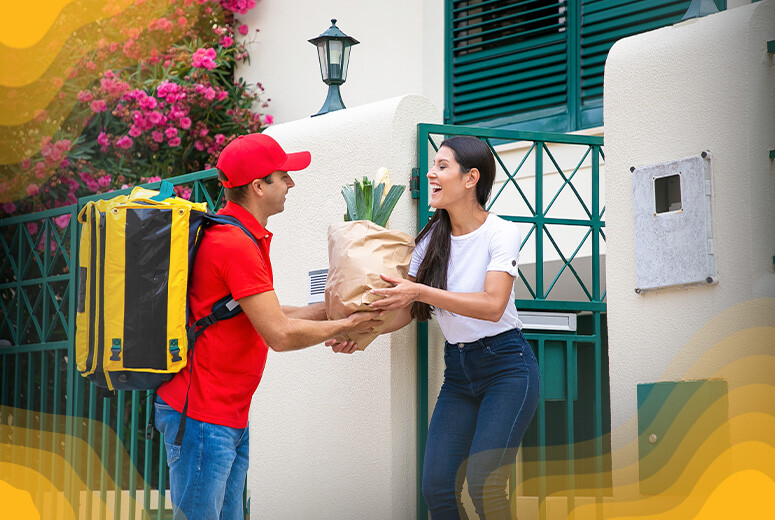Key Insights
-
In today’s competitive world, customers expect immediate, transparent, and accurate delivery of their purchase
-
Customer experience has become the key to building loyalty and trust in on-demand delivery services
-
Brands can make it a reality by putting the right technology in place. This will help them to communicate efficiently and strike deeper connections with customers.
On-demand delivery services have witnessed steady growth over the years, charting the path for innovation and success.
With the pandemic, the steady expansion gave way to a sudden explosion in demand.
A report by IBM states that the wide-scale disruptions of the past two years have powered a shift away from stores to online shopping by close to five years.
This sudden growth of the e-commerce ecosystem has brought sharp focus to the capabilities of on-demand delivery services.
An on-demand delivery service can be described as a business that provides an order to a customer within hours or even minutes. Many SaaS providers have changed the way on-demand delivery works. Take DoorDash and Uber for instance.
What these services require is hyperfocus on creating a better customer experience from the customer’s perspective.
But before we jump into approaches that can be employed to be customer-obsessed, let’s understand why it is vital.
Why is Customer Obsession Important?
Customer obsession is essentially a business that puts its focus on delivering the most value to its ideal customers. Connectivity is the key. So are user interfaces, customer service channels, top-down and bottom-up team communication, and customer feedback cycles.
As customer obsession entails a consistent effort to better the buyer’s journey, your clients are more dependent on you and your brand. Consequently, they begin augmenting their frequency of purchases, and in the process, advocate your brands to more people.
What is the Difference Between Customer Service & Customer Obsession?
Think of customer service as the individual interactions your customers have with your company. This includes the assistance they are provided with before, during, and after their purchase.
On the other hand, customer obsession is your customer’s overall journey with your company, and how it made them feel. The overall customer experience is the foundation on which they will talk about you to people in their lives.
Some of the most successful companies across the globe are focusing on becoming customer-obsessed brands. Take Disney for instance.
Disney goes above and beyond to create a world-class customer experience. And it’s reflected in everything they do–from treating all guests to their parks as VIPs to cutting-edge training for their staff.
How Do You Achieve Customer Obsession?
In most cities, on-demand delivery is now a part of everyday life, making the customer experience a critical game-changer.
A common assumption is that the customer experience journey starts when the customer has placed the order. However, the customer starts interacting with the logistic provider much before that.
To help you navigate the ecosystem, we have listed down steps that you can incorporate into your on-demand delivery for a better customer experience.
Step #1. Pre-purchase Customer Experience
Your customer’s expectations begin before the order is even placed. Suggest the best possible slots to them but the flexibility of making a choice should rest with the customer.
Automation will allow you to provide instant quotes to your users. However, it is necessary that you have those delivery times and convenient fulfillment options set up in the first place.
Step #2. Synced-up Process
From the moment an order is placed to the time it reaches your customer’s door, your delivery process should be coordinated and digitized end-to-end.
This will enable you to have visibility over your operations. When you have visibility across the entire last-mile flow, you are better equipped to utilize your existing resources to complete demand deliveries.
Step #3. Discounted Delivery Services
Cart abandonment is at an all-time high. Why? Because 40% of customers will leave a shopping cart if there is no free shipping, according to the survey of European customers by Sendcloud.
When consumers are increasingly driven to choose brands that offer discounted rates, make way for such a model in your own on-demand delivery service.
Step #4. Third-Party Services
On-demand delivery entails the ability to meet your customer’s demand, irrespective of the time or day. You can enhance your capabilities by adding third-party delivery solutions to your existing fleet management tools.
By doing this, you can also enhance brand awareness and sustain your customers’ satisfaction.
Step #5. Automation
Automation during the purchasing stage is just a small facet of its potential.
Automation must be embedded into every aspect of your on-demand delivery process to augment customer experience.
An automated system will make the right decisions based on business rules pertaining to cost, volume, and other goals. It can also help you to determine whether the delivery should be done in-house or outsourced to third parties.
Step #6. The Human Element
While automation can free your teams from more repetitive tasks, it is important to remember that your customers would want a human touch to get their queries solved.
So, you can make use of chatbots who will take care of your customers’ queries, but make sure to design the automated system in a humane way with the possibility for your customers to speak to your personnel at the end.
The Way Ahead
On-demand delivery services are more than just offering an app to customers.
It is about restructuring your entire last-mile delivery operations for enhanced customer experience and fast and quick fulfillment.
With customer behavior changing, putting speed and convenience at the top of the list, customer-obsessed companies are recalibrating their model to deliver a smooth last-mile experience.
This is the first installment in our series on Customer Obsession where we look into the benefits of having a customer-obsessed mindset and how it will help businesses understand what’s motivating their customers.
Head over to Growth Hub at MarketStar and discover more insights.






